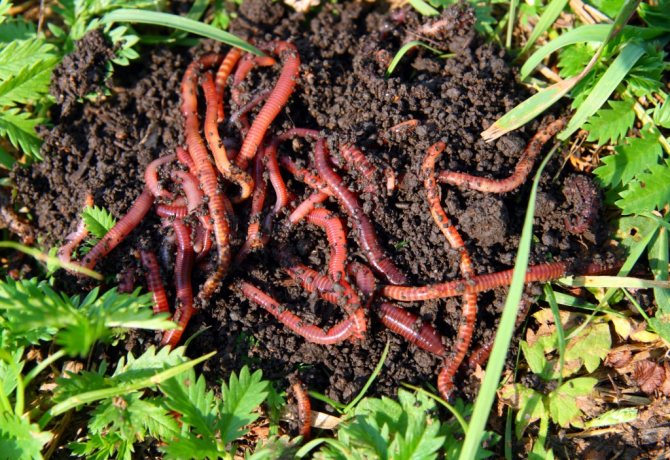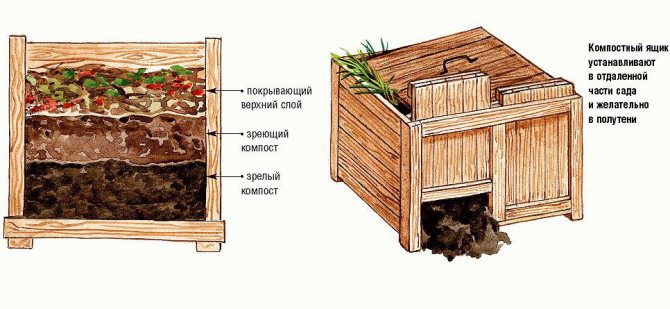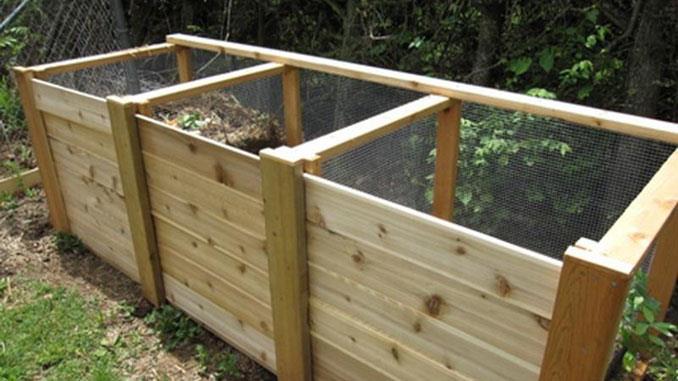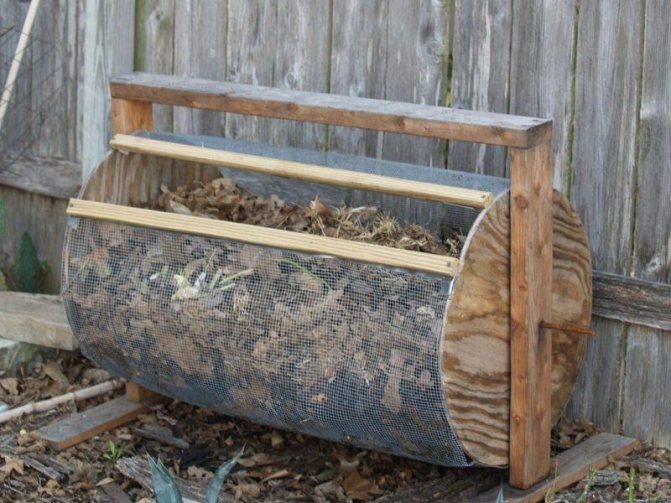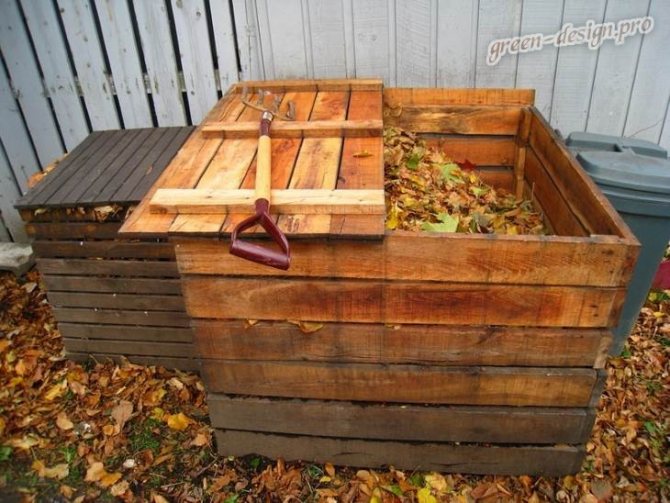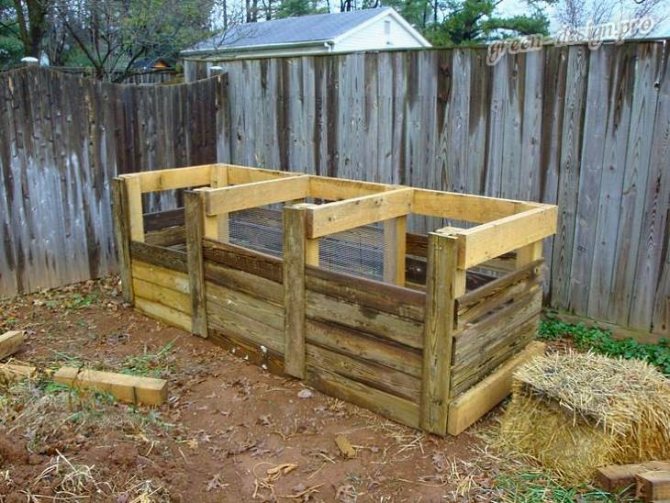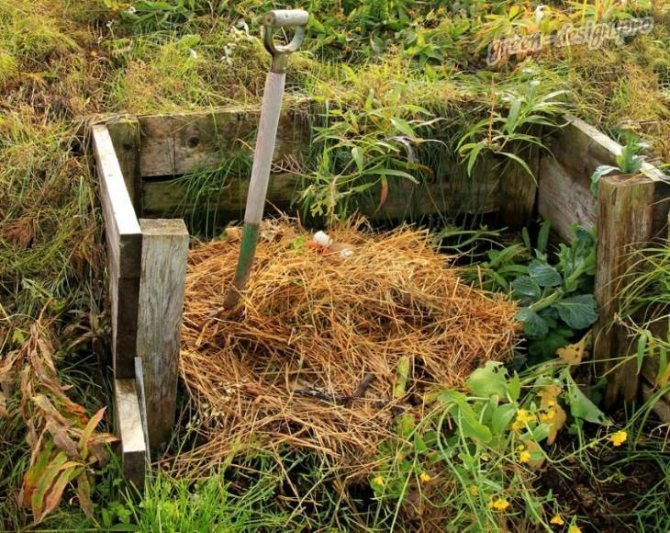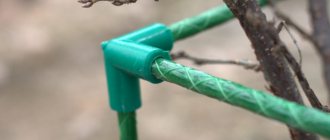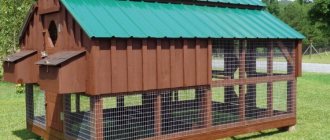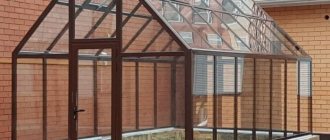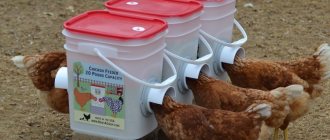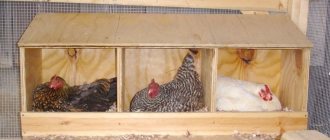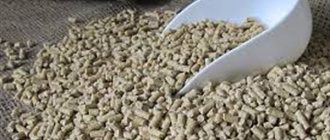If you are not indifferent to the ecological situation in the country and the world, post your publication
Publish article
Home ›Good to know
Improving soil fertility is a constant task of any land user. Another problem that every ordinary summer resident faces is the destruction or disposal of organic waste of plant origin that is formed in the garden. The easiest way - burning - is not the most successful. First, it is fire hazardous. Secondly, it is smoke, which irritates the eyes, and the place of burning, on which nothing grows for a long time. In this article, we will offer an ecological way to solve both problems: we will learn how to make compost bins for our own needs with our own hands.
- What to make: wood, slate, plastic?
Photo gallery of structures made of various materials
- DIY wooden compost box
Photo gallery of boxes for humus made of wood with drawings and examples of execution
- Options for a beautiful compost bin camouflage
Compost box - humus reactor
Composting is the overheating or decomposition of organic residues, plant waste with the help of earthworms, bacteria, microorganisms with the formation of the final product of humus or, in other words, humus. The decay period is about 12-18 months and depends entirely on the number of microorganisms, temperature, humidity, oxygen enrichment (air access).
In order for the overheating of organic matter to proceed steadily, it is necessary to provide conditions for the growth and vital activity of microorganisms, the creation of a microclimate. The most complete observance of these factors can be achieved using a container for these purposes. A box, box, barrel or pit can serve as it. Let's dwell on the most common option - a box.
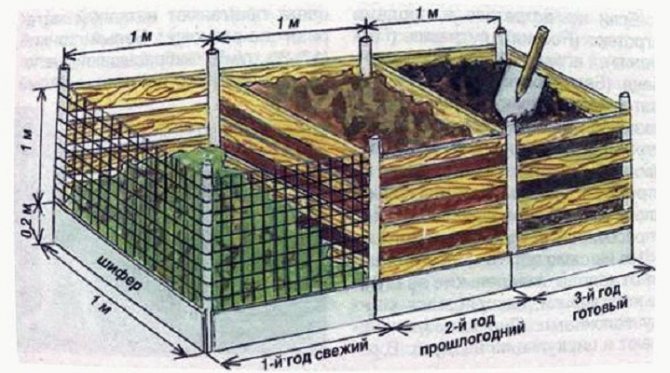
To ensure the continuity of the process, the compost bin is divided into sections
The compost box is designed and necessary for the correct and compact placement of organic waste and the vital activity of microorganisms. The use of the design makes it possible to provide the biomass of microorganisms that "eat" plant residues, protection from rain, wind, and create a temperature favorable for the reaction.
The compost box is a box with side openings for air access with dimensions of 1.5–3 cm. The design can be one-piece or have several sections or compartments. The size of the box also varies, but it is advisable to adhere to the following standard: 2 x 1 x 1.5 m (height).
Divide the box into sections in order to separate the last year's compost from the fresh one. The bottom is covered with a net, and the drawer itself is installed on a pallet with an openable lower door or pull-out drawer.
The idea of using the "reactor" is that raw materials - plant residues, manure, foliage and tree branches are loaded into a container with a rotting environment through the top cover.As expected, not without the help of living microorganisms, the mixture begins to rot, rot, decrease in size and break down into smaller fractions.
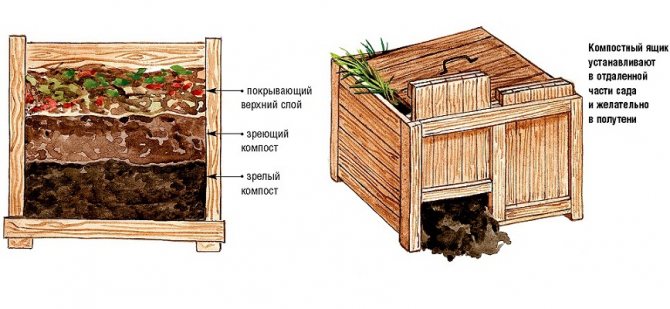

After a certain period of time, crushed rotted plant waste, turned into humus, is selected for the needs of the gardener
After a certain period of time, the crushed plant waste falls through the mesh installed inside the box and is picked up with a shovel through the lower door for application as fertilizer to the garden. The process is somewhat remotely reminiscent of the combustion of wood in a furnace, followed by the settling and removal of ash.
DIY manure and humus box construction
You can compost not only plant waste, but also cattle manure and poultry droppings. These are nitrogen-containing substances and the primary task is to preserve it. You need to know how to properly make a manure or humus box.
For information: in rotted manure, the nutrient content is reduced by 50%. That is, such manure is no longer used as a top dressing. It is only suitable for application to the soil to restore the soil and feed bacteria.
Manure is stored in two ways - cold and hot. In the first case, litter manure is piled tightly into a pile and tamped so that less air gets inside.
Such a pile will not burn and the beneficial nutrients will last longer. The box for the cold composting method is made airtight - the boards are nailed close to each other. The lid is also sealed. After laying the manure, you will need to cover it with grass, earth, or straw.
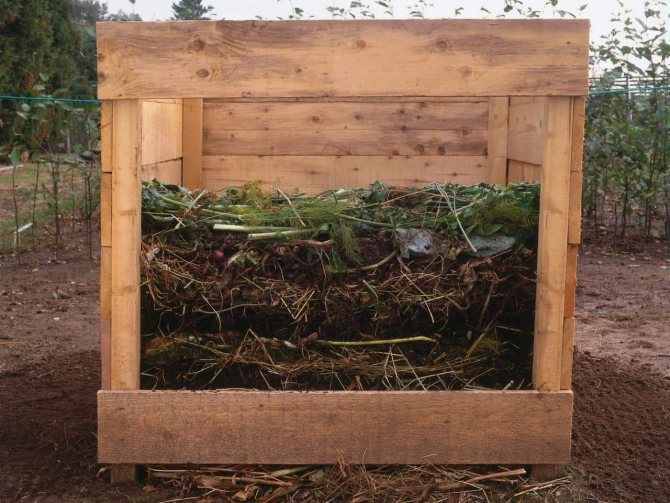

Hot storage of manure requires oxygen, so the boards are wider. After maturation and overheating, excess liquid evaporates, the substance loses its original volume and weight.
To preserve the remnants of nutrients, humus is covered from rain and other precipitation. It is not recommended to bring manure to an extreme state, because then you will have to add mineral fertilizers to provide nutrition to the plant.
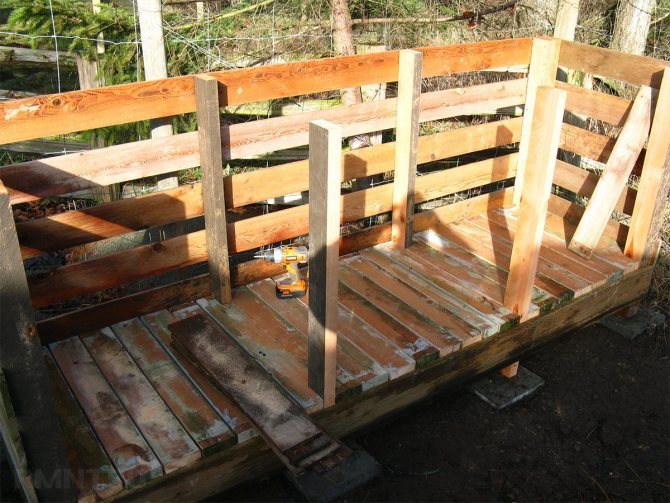

What to make: wood, slate, plastic?
The compost bin can be made from most commonly available materials. These are boards, wooden slats, galvanized metal and metal corners, as well as slate, plastic, polyethylene, netting. The main requirements are environmental friendliness, durability, availability and low cost.
- Wood. Anything can be used! Boards, slats, plywood sheets, pallets. When using wood, it must be treated with a protective layer. Paint works well (with the exception of oil paint). Otherwise, moisture and wind will do their job, and the material will quickly fail, and with it the whole structure.
- Metal. It makes sense to use a metal that has corrosion protection. It can be galvanized iron or aluminum sheet. Metal very quickly "picks up" the temperature and also quickly gives it back. When using it as the walls of the box, be sure to provide slots for enriching humus raw materials with oxygen and insulation, ensuring the maintenance of a temperature favorable for the reaction in the box.
- Slate. Brittle, easily cracking material. All the strength of the slate is based on the wavy shape, which serves as the stiffening ribs. Not environmentally friendly. It keeps heat better than metal and plastic, but worse than wood. It is advisable to use as a roof or top of a box. Cheap.
- Plastic, polyethylene. Strong enough. Non-ecological. With even a slight heating (enough solar heat in the summer), toxic substances are emitted. The material is resistant to corrosion and moisture. It does not allow air to pass through, therefore it is recommended to equip holes when used as side walls of the box
Photo gallery of structures made of various materials
A kind of compost box made of wood Rotating compost block Wood remains the most preferable and affordable material Iron, covered with a protective layer of paint, the box will serve for a long time Using plastic, as a material increases the durability of the product When using slate, it is necessary to take into account the fragility of the material
Top manufacturers
Kekilla Global (Finland)
Perhaps the first place can be assigned to the Finnish manufacturer Kekilla. Their composters have excellent frost resistance and are therefore considered versatile. The most popular Globe has no heavy or small parts. Rounded design, easy to use, safe for children.
Thanks to the high composting speed, the 310 l unit. in terms of the amount of finished fertilizer per season, it is comparable to 600 liters. In addition, the volume can be artificially increased by adding a pair of 160 liter rings, which are purchased separately.
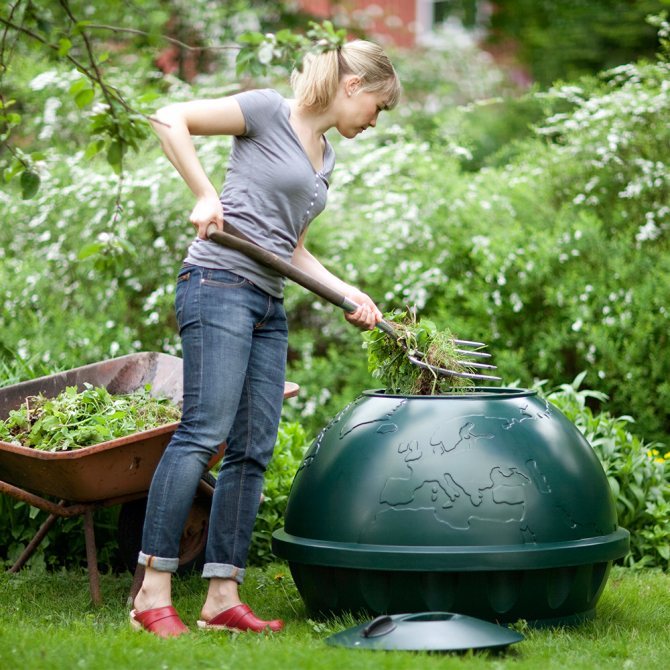

The compost is reliably isolated from the environment, and after maturation it can be easily removed with a shovel. To do this, simply remove the lid and case, opening access to the contents. The Finnish key flag on the composter is a sign of the highest quality of products made from our own raw materials.
Step-by-step instructions for correct manufacturing


Chain-link structures are no less beautiful.
DIY wooden compost box
To make such a box, you will need some materials and tools. At the first stage, you need to pick up the lumber. For supports, "fifty" bars with a length of 1.5 m are suitable. The walls of the box are made of laths 1 m long, provided that the size of the box itself is 1m3. Also, for the walls of the box, you can use OSB or chipboard material.
Of the tools you will need:
- hand or electric saw;
- level at least 50 cm long;
- roulette;
- scrap for making depressions in the ground;
- large hammer or sledgehammer;
- nails or wood screws and a screwdriver.
Operating procedure:
- Initially, we take 4 bars, measure a square with sides of 1 m with a tape measure on the ground, and dig in wooden bars in the corners to a depth of 0.5 m.
- Next, on the sides, we begin to attach the slats to the bars (best of all with screws, since nails can damage the slats due to sharp blows).
- After the frame of the box is ready, we make a cover made of moisture-resistant OSB material and attach it to the box on awnings or on thick pieces of rubber. This should be done so that the lid protects the contents from wind and rain. The inner walls of the box can be upholstered with polyethylene to maintain a constant rotting temperature.
Photo gallery of boxes for humus made of wood with drawings and examples of execution
In this case, the side walls are made low The easiest way to make a box from boards and wooden blocks This diagram defines the assembly of the compost box.
How to build a box of pallets on the site
This type of compost bin is made from wooden pallets without the use of screws or nails. The boards are fastened with slots made in them.
From the tools you will need:
- hand saw or jigsaw;
- roulette;
- a hammer;
- assembly glue and a gun to it;
- level not less than 50 cm.
Assembly order:
- First you need to disassemble the pallets and make slots in the boards for fastening. A jigsaw will help you with this, since without it, it is quite problematic to cut the necessary holes and slots.
- After preparing the boards, assemble the structure in such a way that all the boards acquire an upright position, and one side is tilted. This is necessary to extract the humus.
- It is imperative to coat the seams between the boards with assembly glue.This provides a more rigid coupling of the entire structure. An important point at the beginning of the assembly of the structure is the leveling of the first boards to prevent the box from skewing.
- After installing all the boards, it is advisable to paint the box with an antifungal solution, so it will last longer and will be an excellent source of organic fertilizers.
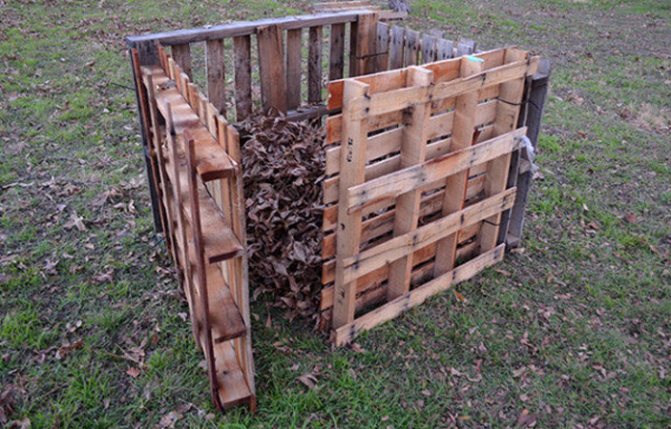

Pallet box variant without tilt
Video about brick making technology from a professional
How to disguise and use
The installation of the compost bin is mainly carried out on the outskirts of the site, near outbuildings, in the most secluded place. The very sight and smell of rotting plant residues is not a sight for the faint of heart.
After the place for the box is determined, we proceed to design solutions that will hide all the disadvantages of the compost heap. You can make a metal frame that will cover the top and sides of the compost box, and put climbing plants (loaches, climbing roses, etc.) on this frame. Thus, the compost bin with an unpleasant smell and appearance will be hidden and turn into a blooming oasis that spreads the aromas of flowers.
Another option, how you can hide the appearance of the compost box, is to plant near one-year-old plants with wide leaves (squash, squash, pumpkin, etc.). In this case, you can not only hide the shortcomings of the compost box, but also get a good vegetable harvest in the fall.
Options for a beautiful compost bin camouflage
This design solution will allow you to harvest a good harvest The metal frame and juicy greens reliably hide the compost box Annual plants of the pumpkin family are well adapted to grow in soils with a high content of organic substances The lid on the box can be made in the form of a flower bed with annual flowering plants
The compost box should be filled with plant residues that do not have external chemical treatment against pests; coarse perennial rhizomes should also not be put in the box. When the compost bin is full, it is necessary to periodically stir the contents in order to provide oxygen to the organisms that provide the decay process. And in case of dry weather, it is necessary to water the contents to accelerate the process of decay and the formation of organic fertilizer.
Making a compost box with your own hands will ensure the disposal of the garden plot from organic residues, and the fertilization itself will bring a sufficient amount of environmentally friendly substances to the soil, contributing to the intensive development of plants.
Improving soil fertility is a constant task of any land user. Another problem that every ordinary summer resident faces is the destruction or disposal of organic waste of plant origin that is formed in the garden. The easiest way - burning - is not the most successful. First, it is fire hazardous. Secondly, it is smoke, which irritates the eyes, and the place of burning, on which nothing grows for a long time. In this [...]
—>
- What to make: wood, slate, plastic?
Photo gallery of structures made of various materials
- DIY wooden compost box
Photo gallery of boxes for humus made of wood with drawings and examples of execution
- Options for a beautiful compost bin camouflage
Domestic composters
The composter is in great demand among gardeners. This is a domestic cone-shaped model. The four sidewalls are bolted together. The volume of the product is 1000 liters.


The composter is made of propylene with undulating walls. The structure is easy to assemble and disassemble.The appearance of the product allows you to place it anywhere on the site. The compost in it is of good quality. The shops have a large selection of composters of various shapes and designs.
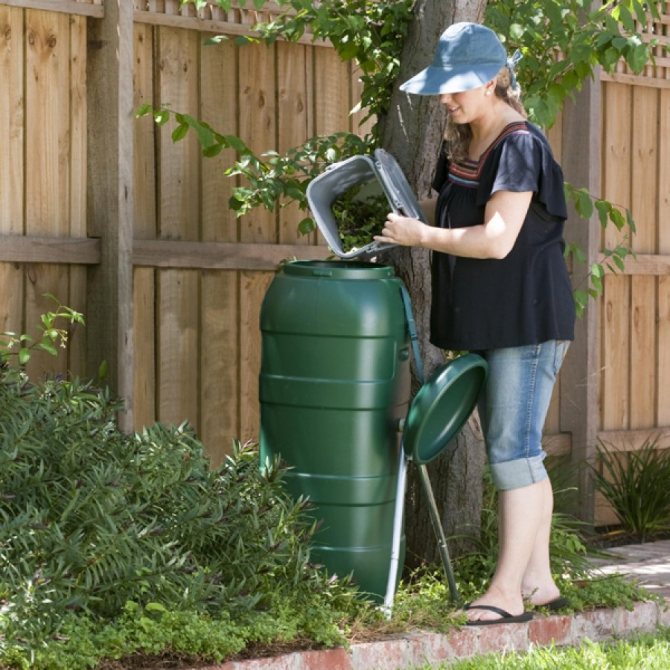

So, the useful accumulation of waste will help solve the problem of disposal and enrich the site with valuable fertilizer. It should be remembered that according to sanitary standards, composters should be located at a distance of 20 m from water supply sources and 10 m from residential buildings.
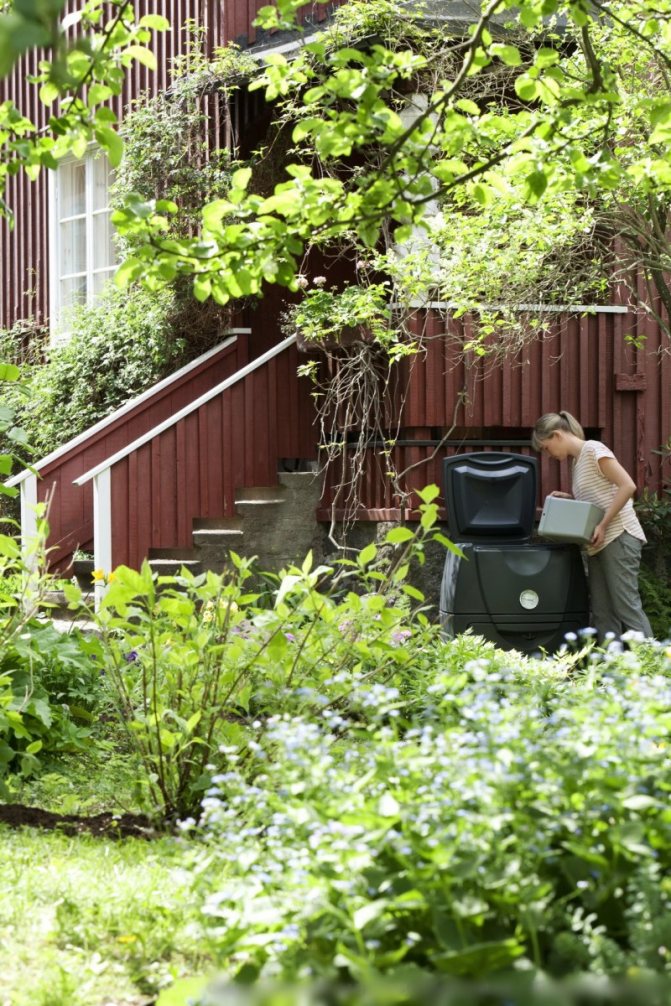

There are many options for making and buying garden products for obtaining fertilizer. In favor of which composter to make a choice, decide for yourself.
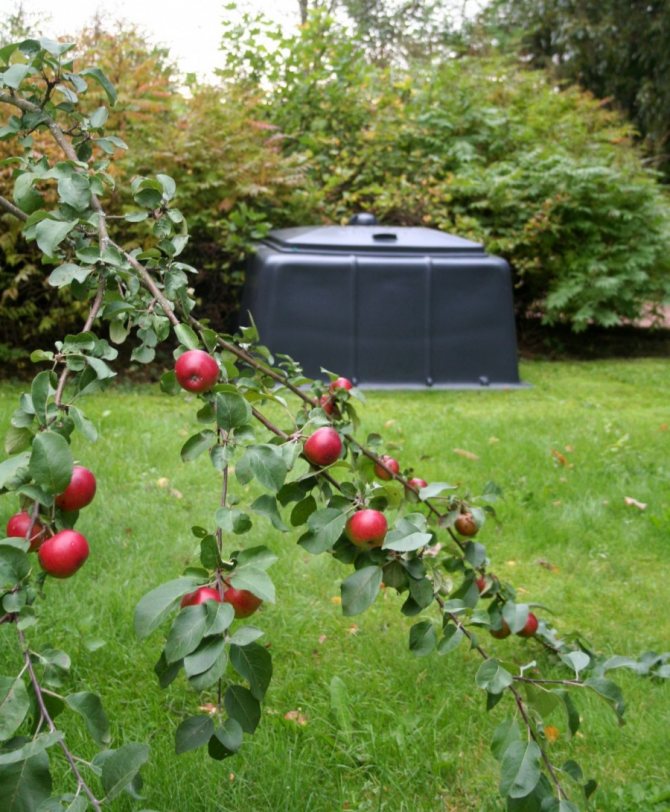

Compost box - humus reactor
Composting is the overheating or decomposition of organic residues, plant waste with the help of earthworms, bacteria, microorganisms with the formation of the final product of humus or, in other words, humus. The decay period is about 12-18 months and depends entirely on the number of microorganisms, temperature, humidity, oxygen enrichment (air access).
In order for the overheating of organic matter to proceed steadily, it is necessary to provide conditions for the growth and vital activity of microorganisms, the creation of a microclimate. The most complete observance of these factors can be achieved using a container for these purposes. A box, box, barrel or pit can serve as it. Let's dwell on the most common option - a box.
To ensure the continuity of the process, the compost bin is divided into sections
The compost box is designed and necessary for the correct and compact placement of organic waste and the vital activity of microorganisms. The use of the design makes it possible to provide the biomass of microorganisms that "eat" plant residues, protection from rain, wind, and create a temperature favorable for the reaction.
The compost box is a box with side openings for air access with dimensions of 1.5–3 cm. The design can be one-piece or have several sections or compartments. The size of the box also varies, but it is advisable to adhere to the following standard: 2 x 1 x 1.5 m (height).
Divide the box into sections in order to separate the last year's compost from the fresh one. The bottom is covered with a net, and the drawer itself is installed on a pallet with an openable lower door or pull-out drawer.
The idea of using the "reactor" is that raw materials - plant residues, manure, foliage and tree branches are loaded into a container with a rotting environment through the top cover. As expected, not without the help of living microorganisms, the mixture begins to rot, rot, decrease in size and break down into smaller fractions.
After a certain period of time, crushed rotted plant waste, turned into humus, is selected for the needs of the gardener
After a certain period of time, the crushed plant waste falls through the mesh installed inside the box and is picked up with a shovel through the lower door for application as fertilizer to the garden. The process is somewhat remotely reminiscent of the combustion of wood in a furnace, followed by the settling and removal of ash.
Urn with a lid
The trash can is often installed in an open area. In this case, it is advisable to protect its contents from rain. Make an urn with a lid:
- Take the disc from the old wheel. It will make a perfect stable base for the urn.
- Using aluminum strips or a metal profile, connect the disc to a regular bucket. Use bolts or self-tapping screws to connect. The bucket is fixed in such a way that the strips or profile protrude at least 10 cm above its upper edge.
- Attach the cover to the top of the structure. This can be a lid from a bucket or any saucepan of the corresponding diameter.


What to make: wood, slate, plastic?
The compost bin can be made from most commonly available materials. These are boards, wooden slats, galvanized metal and metal corners, as well as slate, plastic, polyethylene, netting. The main requirements are environmental friendliness, durability, availability and low cost.
- Wood. Anything can be used! Boards, slats, plywood sheets, pallets. When using wood, it must be treated with a protective layer. Paint works well (with the exception of oil paint). Otherwise, moisture and wind will do their job, and the material will quickly fail, and with it the whole structure.
- Metal. It makes sense to use a metal that has corrosion protection. It can be galvanized iron or aluminum sheet. Metal very quickly "picks up" the temperature and also quickly gives it back. When using it as the walls of the box, be sure to provide slots for enriching humus raw materials with oxygen and insulation, ensuring the maintenance of a temperature favorable for the reaction in the box.
- Slate. Brittle, easily cracking material. All the strength of the slate is based on the wavy shape, which serves as the stiffening ribs. Not environmentally friendly. It keeps heat better than metal and plastic, but worse than wood. It is advisable to use as a roof or top of a box. Cheap.
- Plastic, polyethylene. Strong enough. Non-ecological. With even a slight heating (enough solar heat in the summer), toxic substances are emitted. The material is resistant to corrosion and moisture. It does not allow air to pass through, therefore it is recommended to equip holes when used as side walls of the box
Photo gallery of structures made of various materials
A kind of compost box made of wood Rotating compost block Wood remains the most preferable and affordable material Iron, covered with a protective layer of paint, the box will serve for a long time Using plastic, as a material increases the durability of the product When using slate, it is necessary to take into account the fragility of the material
Compost bin options
Today, do-it-yourself garden composters for summer cottages are becoming popular among the people, since they do not require special financial investments, they are made quickly from scrap materials. Tank options:
- an ordinary wooden box;
- a plastic container in the form of a container with openings for free oxygen access and ventilation inside;
- thermo-composter for keeping heat and performing chemical processes all year round.
The note! You can make and install on your own garden a wooden box or compost pit. The main thing is to decide on the purpose, to outline the basic requirements for production.
DIY garden composters are becoming popular
Step-by-step instructions for correct manufacturing
Chain-link structures are no less beautiful.
DIY wooden compost box
To make such a box, you will need some materials and tools. At the first stage, you need to pick up the lumber. For supports, "fifty" bars with a length of 1.5 m are suitable. The walls of the box are made of laths 1 m long, provided that the size of the box itself is 1m3. Also, for the walls of the box, you can use OSB or chipboard material.
Of the tools you will need:
- hand or electric saw;
- level at least 50 cm long;
- roulette;
- scrap for making depressions in the ground;
- large hammer or sledgehammer;
- nails or wood screws and a screwdriver.
Operating procedure:
- Initially, we take 4 bars, measure a square with sides of 1 m with a tape measure on the ground, and dig in wooden bars in the corners to a depth of 0.5 m.
- Next, on the sides, we begin to attach the slats to the bars (best of all with screws, since nails can damage the slats due to sharp blows).
- After the frame of the box is ready, we make a cover made of moisture-resistant OSB material and attach it to the box on awnings or on thick pieces of rubber. This should be done so that the lid protects the contents from wind and rain. The inner walls of the box can be upholstered with polyethylene to maintain a constant rotting temperature.
Photo gallery of boxes for humus made of wood with drawings and examples of execution
In this case, the side walls are made low The easiest way to make a box from boards and wooden blocks This diagram defines the assembly of the compost box.
How to build a box of pallets on the site
This type of compost bin is made from wooden pallets without the use of screws or nails. The boards are fastened with slots made in them.
From the tools you will need:
- hand saw or jigsaw;
- roulette;
- a hammer;
- assembly glue and a gun to it;
- level not less than 50 cm.
Assembly order:
- First you need to disassemble the pallets and make slots in the boards for fastening. A jigsaw will help you with this, since without it, it is quite problematic to cut the necessary holes and slots.
- After preparing the boards, assemble the structure in such a way that all the boards acquire an upright position, and one side is tilted. This is necessary to extract the humus.
- It is imperative to coat the seams between the boards with assembly glue. This provides a more rigid coupling of the entire structure. An important point at the beginning of the assembly of the structure is the leveling of the first boards to prevent the box from skewing.
- After installing all the boards, it is advisable to paint the box with an antifungal solution, so it will last longer and will be an excellent source of organic fertilizers.
Pallet box variant without tilt
Video about brick making technology from a professional
How to disguise and use
The installation of the compost bin is mainly carried out on the outskirts of the site, near outbuildings, in the most secluded place. The very sight and smell of rotting plant residues is not a sight for the faint of heart.
After the place for the box is determined, we proceed to design solutions that will hide all the disadvantages of the compost heap. You can make a metal frame that will cover the top and sides of the compost box, and put climbing plants (loaches, climbing roses, etc.) on this frame. Thus, the compost bin with an unpleasant smell and appearance will be hidden and turn into a blooming oasis that spreads the aromas of flowers.
Another option, how you can hide the appearance of the compost box, is to plant near one-year-old plants with wide leaves (squash, squash, pumpkin, etc.). In this case, you can not only hide the shortcomings of the compost box, but also get a good vegetable harvest in the fall.
Options for a beautiful compost bin camouflage
This design solution will allow you to harvest a good harvest The metal frame and juicy greens reliably hide the compost box Annual plants of the pumpkin family are well adapted to grow in soils with a high content of organic substances The lid on the box can be made in the form of a flower bed with annual flowering plants
The compost box should be filled with plant residues that do not have external chemical treatment against pests; coarse perennial rhizomes should also not be put in the box. When the compost bin is full, it is necessary to periodically stir the contents in order to provide oxygen to the organisms that provide the decay process. And in case of dry weather, it is necessary to water the contents to accelerate the process of decay and the formation of organic fertilizer.
Making a compost box with your own hands will ensure the disposal of the garden plot from organic residues, and the fertilization itself will bring a sufficient amount of environmentally friendly substances to the soil, contributing to the intensive development of plants.
Models
Among the variety of industrial composters, the following three models are distinguished, which differ in their design features:
- Box... This is a simple model that looks like a regular plastic or wooden container with a lid.


Usually, such a device is easy to assemble, disassemble and does not cause inconvenience when moving to a new location. The most demanded volumes of this model are 600 and 800 liters. - Thermocomposter... Acts on the principle of a thermos, keeping the contents warm due to the insulated body. The device can withstand frosts down to -40 ° C. In it, active chemical reactions take place all year round, slowing down only when the temperature drops below -15 ° C. Most often, thermocomposters are made in the form of a barrel or a sphere - this way they keep the temperature better. The model is ergonomic and comfortable to use.
- Vermicomposter. This is an improved composter model in which fermentation takes place by means of earthworms. It has a different design, but a tray-type device is most often used. The container is filled with "plant food", where the worm is then placed. After he has processed the waste in the first tray, a second is installed for him on top, and so on. The vermicomposter can be installed on the balcony, in the garage, in the garden and anywhere. The result of the worm's vital activity is natural biohumus.




